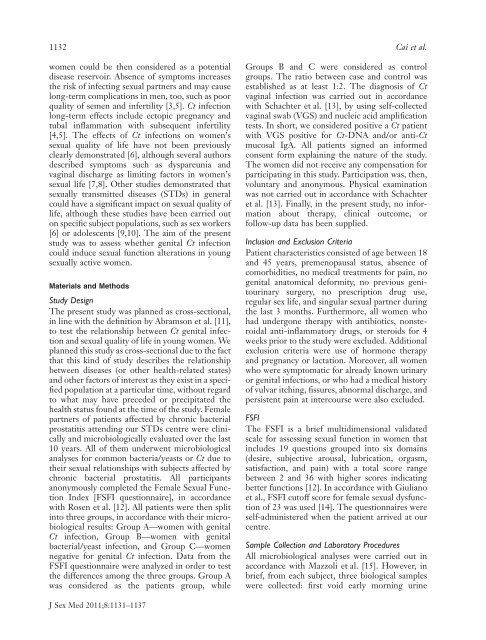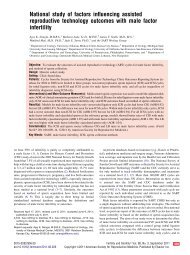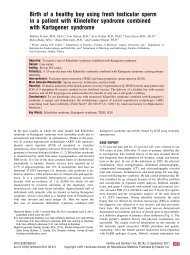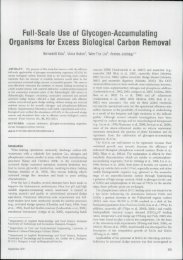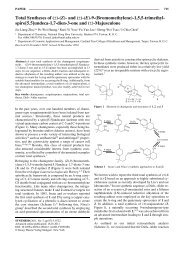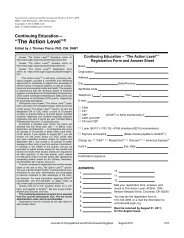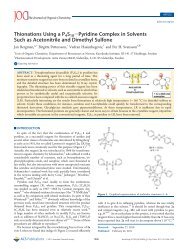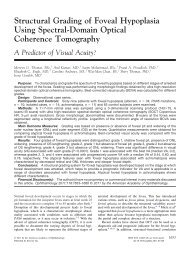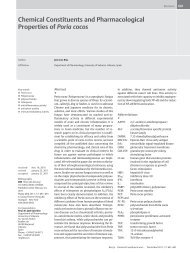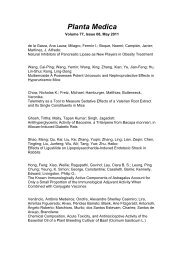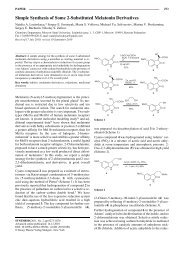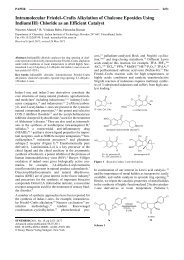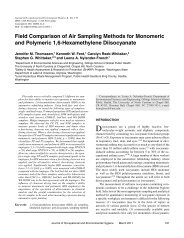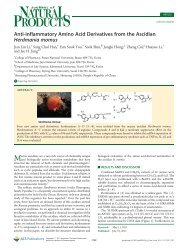Genital Chlamydia trachomatis Infection is Related to Poor Sexual ...
Genital Chlamydia trachomatis Infection is Related to Poor Sexual ...
Genital Chlamydia trachomatis Infection is Related to Poor Sexual ...
You also want an ePaper? Increase the reach of your titles
YUMPU automatically turns print PDFs into web optimized ePapers that Google loves.
1132 Cai et al.<br />
women could be then considered as a potential<br />
d<strong>is</strong>ease reservoir. Absence of symp<strong>to</strong>ms increases<br />
the r<strong>is</strong>k of infecting sexual partners and may cause<br />
long-term complications in men, <strong>to</strong>o, such as poor<br />
quality of semen and infertility [3,5]. Ct infection<br />
long-term effects include ec<strong>to</strong>pic pregnancy and<br />
tubal inflammation with subsequent infertility<br />
[4,5]. The effects of Ct infections on women’s<br />
sexual quality of life have not been previously<br />
clearly demonstrated [6], although several authors<br />
described symp<strong>to</strong>ms such as dyspareunia and<br />
vaginal d<strong>is</strong>charge as limiting fac<strong>to</strong>rs in women’s<br />
sexual life [7,8]. Other studies demonstrated that<br />
sexually transmitted d<strong>is</strong>eases (STDs) in general<br />
could have a significant impact on sexual quality of<br />
life, although these studies have been carried out<br />
on specific subject populations, such as sex workers<br />
[6] or adolescents [9,10]. The aim of the present<br />
study was <strong>to</strong> assess whether genital Ct infection<br />
could induce sexual function alterations in young<br />
sexually active women.<br />
Materials and Methods<br />
Study Design<br />
The present study was planned as cross-sectional,<br />
in line with the definition by Abramson et al. [11],<br />
<strong>to</strong> test the relationship between Ct genital infection<br />
and sexual quality of life in young women. We<br />
planned th<strong>is</strong> study as cross-sectional due <strong>to</strong> the fact<br />
that th<strong>is</strong> kind of study describes the relationship<br />
between d<strong>is</strong>eases (or other health-related states)<br />
and other fac<strong>to</strong>rs of interest as they ex<strong>is</strong>t in a specified<br />
population at a particular time, without regard<br />
<strong>to</strong> what may have preceded or precipitated the<br />
health status found at the time of the study. Female<br />
partners of patients affected by chronic bacterial<br />
prostatit<strong>is</strong> attending our STDs centre were clinically<br />
and microbiologically evaluated over the last<br />
10 years. All of them underwent microbiological<br />
analyses for common bacteria/yeasts or Ct due <strong>to</strong><br />
their sexual relationships with subjects affected by<br />
chronic bacterial prostatit<strong>is</strong>. All participants<br />
anonymously completed the Female <strong>Sexual</strong> Function<br />
Index [FSFI questionnaire], in accordance<br />
with Rosen et al. [12]. All patients were then split<br />
in<strong>to</strong> three groups, in accordance with their microbiological<br />
results: Group A—women with genital<br />
Ct infection, Group B—women with genital<br />
bacterial/yeast infection, and Group C—women<br />
negative for genital Ct infection. Data from the<br />
FSFI questionnaire were analyzed in order <strong>to</strong> test<br />
the differences among the three groups. Group A<br />
was considered as the patients group, while<br />
J Sex Med 2011;8:1131–1137<br />
Groups B and C were considered as control<br />
groups. The ratio between case and control was<br />
establ<strong>is</strong>hed as at least 1:2. The diagnos<strong>is</strong> of Ct<br />
vaginal infection was carried out in accordance<br />
with Schachter et al. [13], by using self-collected<br />
vaginal swab (VGS) and nucleic acid amplification<br />
tests. In short, we considered positive a Ct patient<br />
with VGS positive for Ct-DNA and/or anti-Ct<br />
mucosal IgA. All patients signed an informed<br />
consent form explaining the nature of the study.<br />
The women did not receive any compensation for<br />
participating in th<strong>is</strong> study. Participation was, then,<br />
voluntary and anonymous. Physical examination<br />
was not carried out in accordance with Schachter<br />
et al. [13]. Finally, in the present study, no information<br />
about therapy, clinical outcome, or<br />
follow-up data has been supplied.<br />
Inclusion and Exclusion Criteria<br />
Patient character<strong>is</strong>tics cons<strong>is</strong>ted of age between 18<br />
and 45 years, premenopausal status, absence of<br />
comorbidities, no medical treatments for pain, no<br />
genital ana<strong>to</strong>mical deformity, no previous geni<strong>to</strong>urinary<br />
surgery, no prescription drug use,<br />
regular sex life, and singular sexual partner during<br />
the last 3 months. Furthermore, all women who<br />
had undergone therapy with antibiotics, nonsteroidal<br />
anti-inflamma<strong>to</strong>ry drugs, or steroids for 4<br />
weeks prior <strong>to</strong> the study were excluded. Additional<br />
exclusion criteria were use of hormone therapy<br />
and pregnancy or lactation. Moreover, all women<br />
who were symp<strong>to</strong>matic for already known urinary<br />
or genital infections, or who had a medical h<strong>is</strong><strong>to</strong>ry<br />
of vulvar itching, f<strong>is</strong>sures, abnormal d<strong>is</strong>charge, and<br />
pers<strong>is</strong>tent pain at intercourse were also excluded.<br />
FSFI<br />
The FSFI <strong>is</strong> a brief multidimensional validated<br />
scale for assessing sexual function in women that<br />
includes 19 questions grouped in<strong>to</strong> six domains<br />
(desire, subjective arousal, lubrication, orgasm,<br />
sat<strong>is</strong>faction, and pain) with a <strong>to</strong>tal score range<br />
between 2 and 36 with higher scores indicating<br />
better functions [12]. In accordance with Giuliano<br />
et al., FSFI cu<strong>to</strong>ff score for female sexual dysfunction<br />
of 23 was used [14]. The questionnaires were<br />
self-admin<strong>is</strong>tered when the patient arrived at our<br />
centre.<br />
Sample Collection and Labora<strong>to</strong>ry Procedures<br />
All microbiological analyses were carried out in<br />
accordance with Mazzoli et al. [15]. However, in<br />
brief, from each subject, three biological samples<br />
were collected: first void early morning urine


